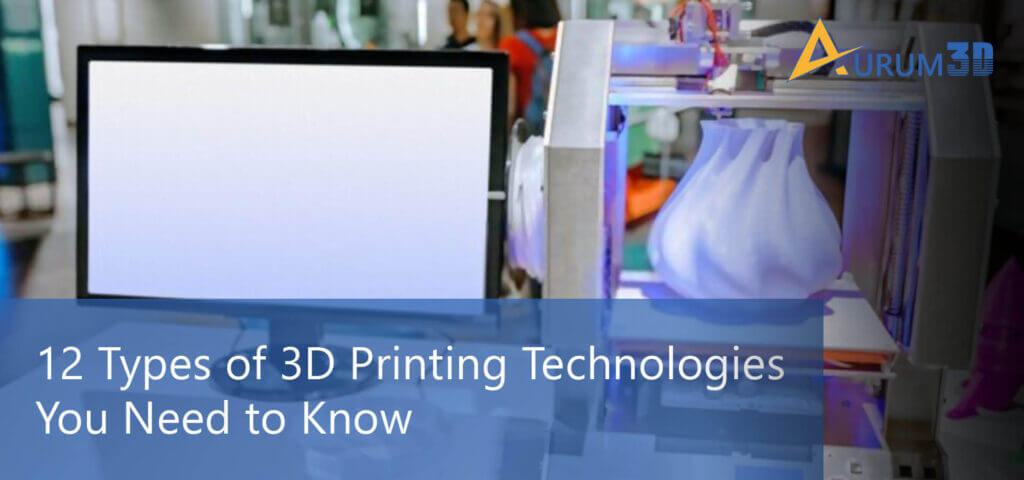Enterprises from various sectors leverage 3D printing as an additive manufacturing process to print consumer and industrial products from digital models. The 3D printers print three-dimensional objects and structures from three-dimensional digital models by depositing thin and successive layers of applications. The manufacturers use a variety of 3D printers to print consumer and industrial products. The 3D printers differ from each other in several aspects including the underlying technology. Each 3D printer uses a specific 3D printing technology. Hence, manufacturers can choose the right 3D printer by understanding and researching about the 11 different Types of 3D printing technologies.
Brief Overview of 12 Commonly Used 3D Printing Technologies
Stereolithography (SLA)
SLA 3D printing is older than other 3D printing technologies. It creates objects, structures and prototypes in a manner similar to SLA printers. Unlike SLA printers, SLA creates three-dimensional objects by exposing photosensitive liquid resin to a UV-laser beam. The printing service providers have to use a digital projector to create the object by curing and hardening the resin. However, SLA is a simple 3D printing technology which deposits one layer of material at a time. SLA technology is generally slower than the advanced 3D printing technologies like DLP.
Fused Deposition Modeling (FDM)
The consumer 3D printers use FDM 3D printing as a form of desktop 3D printing technology. The 3D printers using FDM technology have a control system and a platform extrusion nozzle. The platform extrusion nozzle is used for loading the spool of filament to the 3D printer. The printing service providers heat the nozzle to the desired temperature level and feed the filament through the heated nozzle using a motor. The heat makes the filament melt and 3D printer prints the three-dimensional object by laying the melted filament down in layers onto the build platform. The 3D printer adds the next layer of filament once the first layers become solid.
Digital Light Processing (DLP)
This 3D printing technology produces three-dimensional products just like SLA. But DLP, unlike SLA, cures and hardens the liquid resin using a digital light projector. As a digital screen, the projector composes images of each layer by integrating square pixels. Hence, the projector creates voxels – layers of small rectangular blocks. The technology hardens the liquid resin by delivering light through a UV light source or LED screens. A Digital Micromirror Device – a set of micro-mirrors – redirects the light to the build surface and controls the light projection.
Selective Laser Sintering (SLS)
SLS 3D printing produces three-dimensional objects from nylon, polyamide, and similar sinter powdered material using lasers as the primary source of power. The laser creates a solid object by binding materials together based on the digital 3D model. The powder not utilized during the process provides support to the three-dimensional structure after the printing process. Hence, SLS, unlike certain 3D printing technologies, does require the object external support. SLS is used widely for creating functional parts with complex functionalities.
Selective Laser Melting (SLM)
SLM creates prototypes and industrial products from metallic powders using high power-density lasers. The high power-density laser creates three-dimensional structure by melting and fusing the metallic powder. However, the 3D printers using SLM fuse one layer of the metallic material at a time. Hence, SLM functions in a manner similar to SLS. But SLM, unlike SLS, is effective in fusing and melting metallic powders. In addition to melting the metallic powder fully, it forms homogeneous parts from a single material. Also, the melted metallic powder does not make any structural support necessary for the three-dimensional object.
Laminated Object Manufacturing (LOM)
Laminated object manufacturing is a conventional 3D printing technology which facilitates rapid prototyping. It creates three-dimensional objects by adding layers of build material successively. While creating three-dimensional structures, LOM fuses or laminates layers of paper and plastic by combining heat and pressure. The 3D printer uses a computer-controlled laser or blade to cut the laminated base materials into predefined shapes. At present, LOM does not find extensive use by manufacturers. But many enterprises still opt for LOM as a fast and low-cost 3D printing technology to create prototypes rapidly.
Electron Beam Melting (EBM)
Like SLM, EBM creates three-dimensional structures by melting metal powder. But EBM, unlike SLM, melts the metallic powder using high energy beams or electors. In addition to melting the metallic powder, the electrons fuse particles of the metal powder seamlessly. The high energy density of electrons makes EBM faster than several 3D printing technologies. But the object printed using EBM needs fabrication using vacuum. Also, the manufacturers can use EBM to create three-dimensional objects using only conductive materials.
Material Jetting (MJ)
MJ is considered to be faster and more accurate than other 3D printing technologies. At present, MJ is used widely by manufacturers to create realistic prototypes. This 3D printing technology functions in a manner similar to 2D printing. It created solid objects and structures using photopolymer resin and UV light. The printing service providers spray the photopolymer resin in droplets and use UV light to harden and solidify the droplets. However, MJ keeps depositing layer upon layer of photopolymer till the 3D printing process is over.
Metal Binder Jetting (MBJ)
MBJ finds extensive usage by manufacturers as a low cost metal 3D printing technology. It fabricates three-dimensional metal objects from metal powder using a polymer binding agent. MBJ applies the polymer binding agent on each layer of the metal powder according to the digital 3D model. The metal powder is cured or solidified after each layer. Finally, the three-dimensional object is removed from the printer and cured by placing it into an oven. Unlike conventional manufacturing techniques, MBJ enables manufacturers to print complex geometric patterns.
Sand Binder Jetting (SBJ)
The low cost 3D printing technology produces three-dimensional objects and structures from gypsum, sandstone and similar sands. Many manufacturers opt for SBJ to fabricate parts from plaster-based powder. However, SBJ, like MBJ, uses a polymer binding agent. The 3D printers use multiple printheads simultaneously to produce full color models. The primary printhead jets the polymer binding agent, while the secondary printhead applies the color inks. Hence, the 3D printer produces three-dimensional models in color.
Drop-on-Demand (DOD)
The 3D metal printing technology produces three-dimensional models using droplets of material like wax droplets or photopolymer. It deposits the droplet of materials selectively. The droplets are cured on a build plate. The droplets of material can be easily cured by exposing to light. Hence, the 3D printer deposits a single layer at a time. The 3D printers produce three-dimensional models using a pair of inkjets. The primary inkjet deposits the droplets of material, while the second inkjet dissolves the support material.
Direct Metal Laser Sintering (DMLS)
The 3D printing technology creates three-dimensional objects or structures directly from metal. The 3D printers using DMLS produce solid models using metal powder as the base material. It further uses high power laser beams to melt and fuse multiple layers of metal powder. The 3D printers print the support structure on the base plate before printing the three-dimensional parts. During the printing process, the laser beams are delivered onto the bed of metallic powder while being controlled from a computer. Many manufacturers opt for DMLS to print complex structure or geometry without using wrought iron.
On the whole, each 3D printer use a specific 3D printing technology. Manufacturers or printing service providers cannot differentiate between 3D printers without understanding different types of 3D printing technologies. They must choose the right 3D printing technology to produce a three-dimensional object or structure using the right 3D printer.
About Aurum3D
We are amongst the major 3D printing service providers in Bangalore, India. We have been providing FDM, SLA and SLS custom 3D Printing services to many major industries including multiple disciplines of engineering. Please feel free to get in touch with us for your custom needs, our 3D printing solutions experts will get back to you within one business day.

